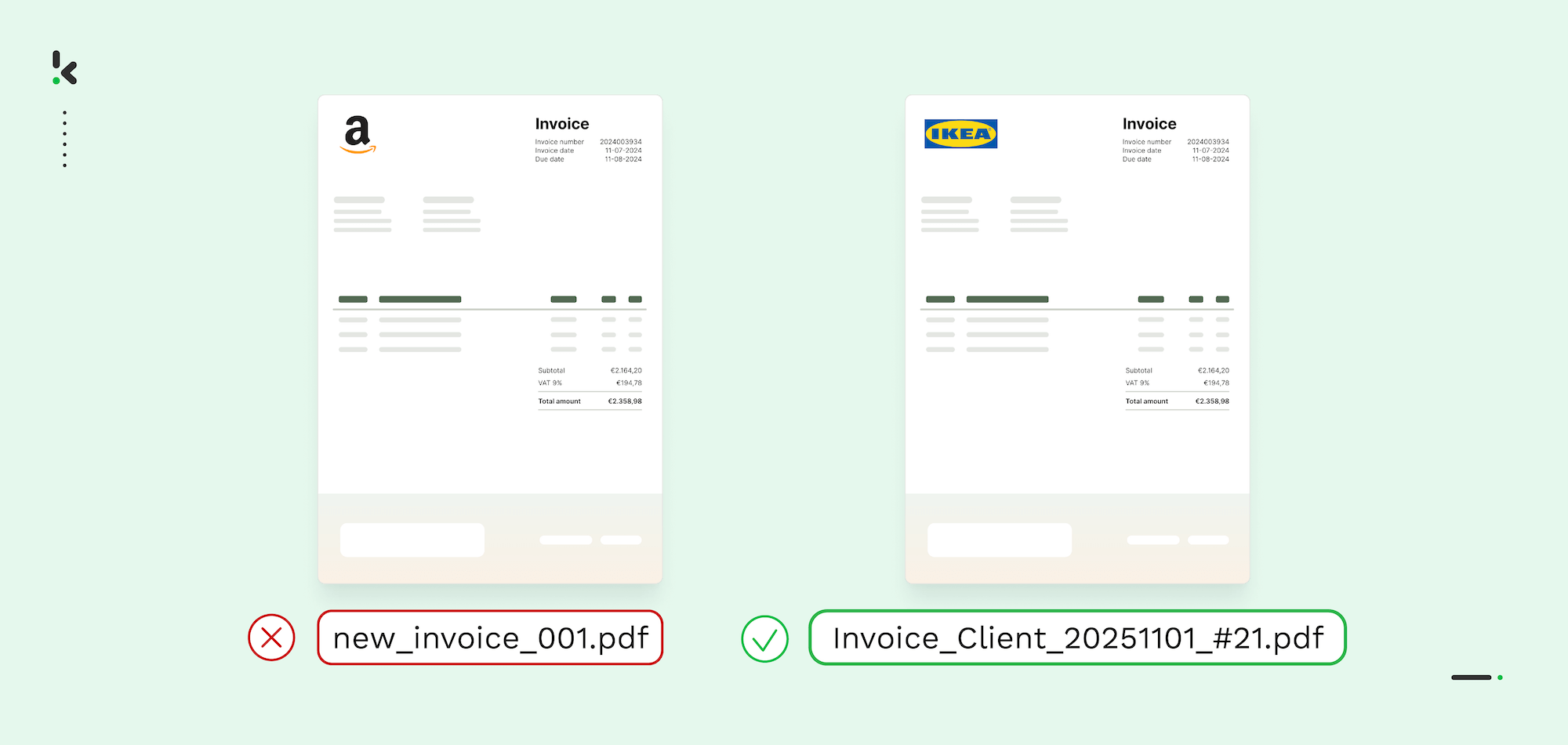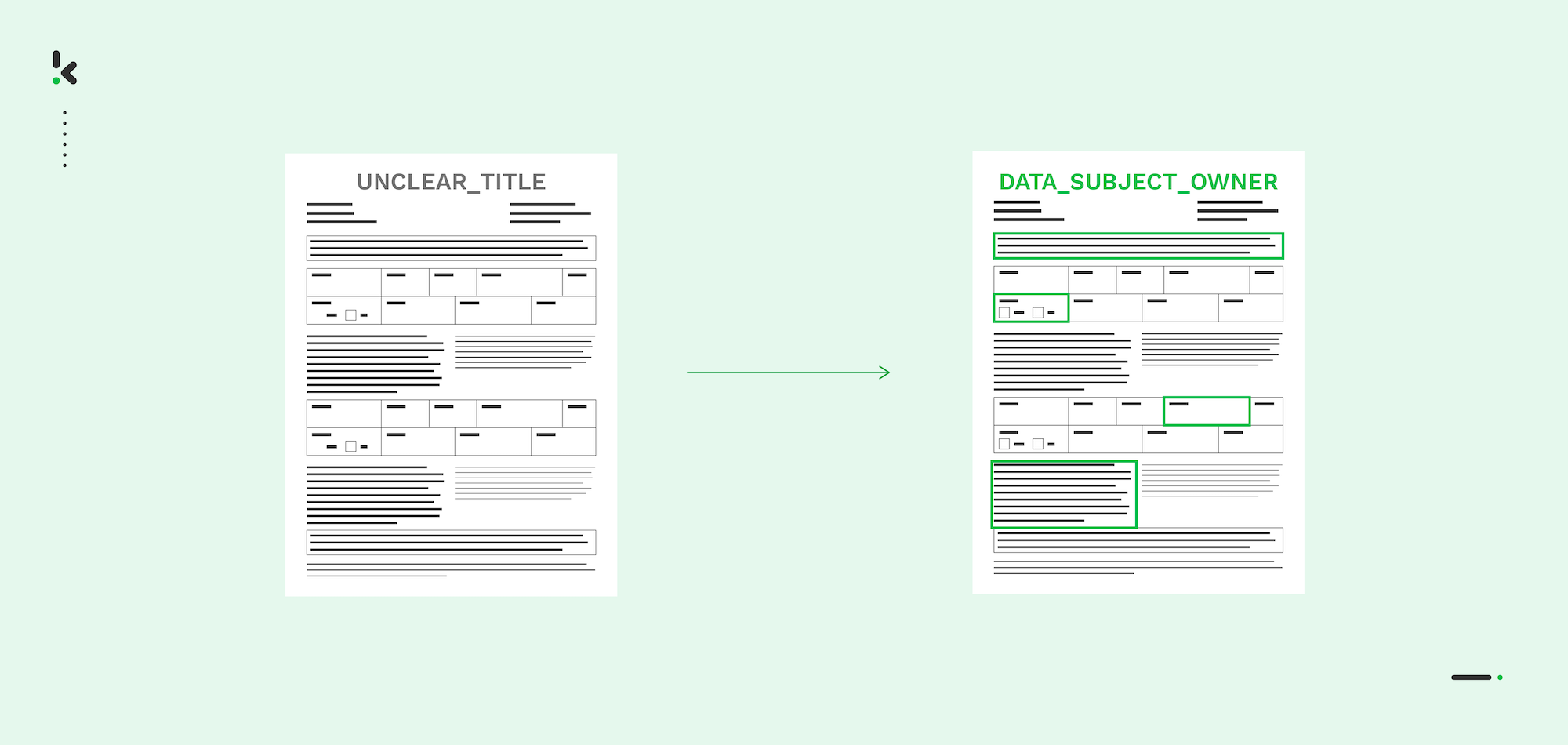

If you’re still opening invoice files one by one just to rename them based on their content, you’re wasting valuable time and likely risking errors. Whether it’s “invoice_001.pdf”, “scan-1234.pdf”, or something even more cryptic, poorly named invoice files clutter your document management system and slow down your processes.
Unstructured or inconsistent invoice file names create inefficiencies across your operations, leading to time loss, decreased productivity, and potential compliance issues.
But here’s the good news: you no longer have to do it manually.
With an Intelligent Document Processing (IDP) solution, you can rename invoice files, identify the right documents in seconds, and extract the insights you need, without ever having to open a single file.
In this guide, we’ll show you exactly how to automatically rename invoices, why it matters, and how Klippa DocHorizon helps you streamline this process from start to finish.
Key Takeaways
- Manual invoice renaming is time-consuming, error-prone, and hard to scale.
- Using Intelligent Document Processing (IDP), businesses can extract data from invoice content and rename files automatically, without the need to open them.
- Automatic file renaming improves consistency, compliance, and document searchability.
- Real-time automation allows you to handle hundreds or thousands of invoices with ease.
- You can fully customize your file naming conventions based on the fields that matter most to your team.
Why Do You Need to Rename Invoices?
Invoices are essential documents in any organization, but their file names often don’t reflect that. You’ve likely encountered invoices titled:
- scan001.pdf
- invoice_final_edited2.pdf
- document-12345.pdf
These vague names offer zero context, making it difficult to search, categorize, or integrate the files into downstream workflows. And when you’re dealing with dozens or hundreds of invoices per week, this disorganization quickly becomes a real operational bottleneck.
Here’s why structured invoice naming is not just helpful, but necessary:
1. Find Files Faster
A well-named invoice like Invoice_ClientABC_20251101_#8392.pdf tells you exactly what’s inside without needing to open it. That alone can save hours each month.
2. Improve Team Collaboration
Finance teams, auditors, and procurement specialists all need access to invoice records. Consistent file names ensure everyone can find the same file without confusion.
3. Ensure Compliance and Audit Readiness
Many regulations, like GDPR, KYC, and AML, require traceable documentation. Poorly named or misplaced invoices can result in non-compliance and audit risks.
4. Enable Automation in Downstream Systems
ERPs, accounting software, and archiving tools often rely on structured file names to match documents to transactions. A consistent naming convention helps unlock end-to-end automation.


How to Rename Invoices: Manual vs Automated Renaming
When it comes to managing invoice files, having meaningful and consistent file names is critical. It ensures documents are easy to find, process, archive, and audit. But how do you get from a randomly named file like scan001.pdf to a clearly structured name like Invoice_ClientXYZ_20251101_#8392.pdf?
There are generally two ways to rename invoices based on their content: manually or automatically using technology. While both approaches aim to bring order and consistency to your document management, they differ significantly in terms of efficiency, accuracy, and scalability.
Let’s take a closer look at each method and what they mean for your business.
Manual Invoice Renaming (The Traditional Way)
Manual renaming is still widely used in organizations that haven’t yet adopted automation. It typically involves a team member going through each invoice file individually, extracting the relevant data, and renaming the file according to internal naming guidelines.
Here’s what the process looks like:
- Open the invoice file manually.
- Review the content to identify key fields like the invoice number, supplier name, and date.
- Rename the file according to your naming convention (e.g. Invoice_ClientABC_20251001.pdf).
- Move the file into the appropriate folder or archive.
While this method may work for small volumes of documents, it becomes a bottleneck as volumes increase. Teams often struggle to keep up, especially when hundreds or thousands of invoices are processed monthly.
The challenges with manual renaming:
- Extremely time-consuming, especially at scale.
- Inconsistent file names due to human error
- Increased workload for finance and administrative teams.
- Not scalable for growing organizations.
- Compliance risks if documents are mislabeled or misplaced.
In short, manual renaming introduces inefficiency and risk, two things no business can afford in today’s fast-paced digital landscape.
Automated Invoice Renaming
Automated invoice renaming, powered by technologies like Intelligent Document Processing (IDP) and Optical Character Recognition (OCR), is a modern approach designed for scale and accuracy.
Rather than relying on a person to open and rename each file, IDP software can scan documents, extract relevant content, and rename the files automatically based on predefined rules.
Here’s how it works:
- Invoices are ingested into the system via email, cloud storage, FTP, or direct upload.
- The software reads the document using OCR (Optical Character Recognition) and AI-based layout analysis.
- Key data points such as invoice number, supplier name, and invoice date are automatically extracted.
- The system renames each file based on your custom naming convention, such as:
Invoice_SupplierName_InvoiceNumber_Date.pdf - The renamed files are exported or stored in your document management system, ERP, or archive, fully organized and ready for use.
The advantages of automated renaming:
- Significantly faster than manual processes.
- Reduces human error, ensuring naming consistency.
- Easily handles large volumes of documents.
- Improves compliance by standardizing naming and storage.
- Boosts searchability and traceability across departments.
With automated invoice renaming, what used to take hours or even days can now be done in minutes, without sacrificing accuracy or control. It offers a structured, future-ready approach that aligns with the demands of modern workflows and scale.
In the next section, we’ll explore an example to show how automated invoice renaming works in practice and the tangible impact it can have on daily operations.
How to Automatically Rename Invoices with AI
In this video, you’ll see how invoices can be automatically renamed by extracting key information such as invoice numbers, supplier names, issue dates, and amounts directly from the document. This automated process creates a structured and consistent file naming convention, making it significantly easier to organize, retrieve, and process invoices at scale.
How It Works with Klippa DocHorizon
By implementing Klippa DocHorizon, the entire renaming process becomes automated, from intake to output. Whether you’re processing a few files or renaming documents in bulk, the platform is designed to scale effortlessly. Below is an overview of the typical workflow, broken down into four simple steps:
Step 1. Submit your invoices
Start by uploading your invoice PDFs through a connected email, cloud folder, or direct server integration; no manual sorting required.
Step 2. Analyze and extract content
The software scans each document, understands its structure, and extracts key data like supplier name, invoice number, and due date.
Step 3. Rename files automatically
Using your custom rules, each file is instantly renamed based on extracted fields such as invoice date, client name, or ID number.
Step 4. Save and organize output
The renamed invoices are saved in the right folder, exported to your ERP, or archived, completely automated from start to finish.
Why Choose Klippa DocHorizon for Invoice Renaming
When it comes to automating invoice renaming, Klippa DocHorizon stands out as the go-to platform for organizations that want speed, accuracy, and scalability without compromising on security or flexibility.
Built for high-volume document workflows, Klippa goes beyond traditional OCR by combining AI-powered data extraction, smart file naming automation, and seamless system integration, all in a single, intelligent solution.
Whether you’re processing hundreds or thousands of invoices, Klippa helps you move faster, reduce errors, and maintain control over every file that enters your system.
And while invoices are a common use case, Klippa DocHorizon is just as effective for renaming PDF files like bank statements, identity documents, permits, contracts, and many more, making it a versatile solution for any document-heavy operation.
What Makes Klippa DocHorizon Stand Out?
- 99%+ data extraction accuracy – Experience unparalleled accuracy in data capture, ensuring every field is recorded correctly.
- AI-powered OCR with layout understanding – Accurately reads and structures data without relying on fixed templates.
- Supports 150+ languages and global document types – Ideal for international vendors and cross-border invoice workflows.
- Flexible output formats – Export renamed files and structured data in JSON, XML, PDF, UBL, CSV, and more.
- Instant integration via API & SDKs – Fast, developer-friendly implementation with full documentation.
- No-code configuration – Set up custom file naming rules and workflows without any technical knowledge.
- Multi-page & batch processing – Handle complex invoices and large volumes effortlessly.
- Privacy-first & compliant – GDPR-compliant, ISO-certified, and equipped with built-in redaction for sensitive data.
If you’re ready to eliminate manual file renaming, enforce consistency, and streamline your invoice workflows, Klippa DocHorizon is the smart choice.
In case you’re curious about how Klippa can help you, contact us for more information or schedule a free demo below.
FAQ
Automatic invoice renaming based on content is the process of using OCR and AI to extract key information, such as invoice numbers, supplier names, and dates, from invoice PDFs and use that data to rename the file, without any manual input.
2. Can I define my own file naming convention?
Yes, with Klippa DocHorizon, you can fully customize the file naming structure based on the fields that matter to your workflow. Common naming conventions include combinations of invoice number, client name, date, or project code.
3. What types of invoice files can be renamed automatically?
Klippa supports a wide variety of file types, including PDF, JPG, PNG, XML, UBL, DOCX, and more. It also processes both native digital invoices and scanned paper documents, even multi-page files.
4. Is this solution compliant with data protection regulations?
Yes. Klippa is fully GDPR-compliant, ISO-certified, and offers built-in document redaction to protect sensitive data. You can also choose between cloud-based or on-premise processing based on your compliance requirements.
5. How does Klippa integrate with my current systems?
Klippa DocHorizon integrates easily via REST API or SDK. It can connect with your ERP, document management system (DMS), accounting software, or cloud storage platform, enabling seamless workflows with minimal setup.
6. What’s the main benefit of automating invoice file renaming?
The main advantage is saving time and reducing errors. Manual renaming is slow and inconsistent, while automation ensures fast, accurate, and scalable processing, improving searchability, compliance, and operational efficiency.
7. Does Klippa only work with invoices?
No. While invoices are a common use case, Klippa DocHorizon is just as effective for renaming PDFs like bank statements, identity documents, permits, contracts, and many more, making it a flexible solution for any document-heavy process.